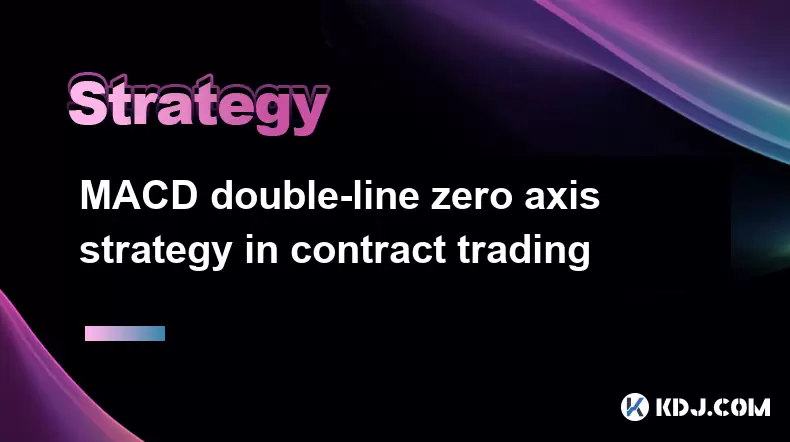-
 bitcoin
bitcoin $114779.865156 USD
2.30% -
 ethereum
ethereum $4226.519789 USD
2.39% -
 tether
tether $1.000545 USD
0.04% -
 xrp
xrp $2.890223 USD
0.92% -
 bnb
bnb $1030.029301 USD
2.95% -
 solana
solana $212.824944 USD
1.69% -
 usd-coin
usd-coin $0.999757 USD
0.01% -
 dogecoin
dogecoin $0.234961 USD
-0.27% -
 tron
tron $0.337174 USD
0.42% -
 cardano
cardano $0.804783 USD
0.09% -
 hyperliquid
hyperliquid $45.748770 USD
-2.85% -
 chainlink
chainlink $21.699170 USD
0.82% -
 ethena-usde
ethena-usde $1.001452 USD
0.08% -
 avalanche
avalanche $30.237800 USD
1.14% -
 stellar
stellar $0.372604 USD
1.52%
MACD double-line zero axis strategy in contract trading
Use MACD double-line zero axis strategy in contract trading: bullish when lines cross above zero, bearish when below. Confirm with RSI, manage risk with stop-losses.
Jun 05, 2025 at 11:42 pm

Introduction to MACD in Contract Trading
The Moving Average Convergence Divergence (MACD) is a popular technical indicator used by traders to identify potential buy and sell signals in various financial markets, including cryptocurrency contract trading. The MACD consists of two lines: the MACD line and the signal line, which help traders gauge momentum and trend direction. A particularly effective strategy within the MACD framework is the double-line zero axis strategy. This strategy focuses on the movements of both the MACD line and the signal line relative to the zero axis, providing insights into potential entry and exit points for trades.
Understanding the MACD Double-Line Zero Axis Strategy
The double-line zero axis strategy revolves around the concept of using the zero axis as a pivotal point for decision-making. When both the MACD line and the signal line cross the zero axis, it can signal a change in momentum and trend direction. Specifically, when both lines move from negative to positive values above the zero axis, it may indicate a bullish trend. Conversely, when both lines move from positive to negative values below the zero axis, it may signal a bearish trend. Traders use these crossings to make informed decisions on when to enter or exit trades.
Identifying Bullish Signals with MACD
To identify bullish signals using the MACD double-line zero axis strategy, traders should look for the following conditions:
- Both the MACD line and the signal line are below the zero axis.
- The MACD line crosses above the signal line.
- Both lines subsequently cross above the zero axis.
When these conditions are met, it suggests a potential shift from a bearish to a bullish market sentiment. Traders can use this signal to enter long positions, anticipating a rise in the asset's price. It's important to confirm these signals with other technical indicators or price action to increase the probability of successful trades.
Identifying Bearish Signals with MACD
For bearish signals, traders should monitor the following conditions within the MACD double-line zero axis strategy:
- Both the MACD line and the signal line are above the zero axis.
- The MACD line crosses below the signal line.
- Both lines subsequently cross below the zero axis.
These conditions indicate a potential shift from a bullish to a bearish market sentiment. Traders can use this signal to enter short positions, anticipating a decline in the asset's price. As with bullish signals, it's beneficial to corroborate these signals with additional technical analysis tools to enhance trading accuracy.
Implementing the Strategy in Contract Trading
To implement the MACD double-line zero axis strategy in cryptocurrency contract trading, follow these detailed steps:
- Choose a reliable trading platform that supports contract trading and offers the MACD indicator.
- Open a chart for the cryptocurrency pair you wish to trade.
- Add the MACD indicator to the chart. Most platforms allow you to do this by selecting 'Indicators' and then choosing 'MACD.'
- Configure the MACD settings according to your preference. The default settings are usually 12, 26, and 9, representing the fast period, slow period, and signal period, respectively.
- Monitor the MACD line and the signal line in relation to the zero axis.
- Identify bullish signals when both lines are below the zero axis, the MACD line crosses above the signal line, and both lines cross above the zero axis. This is a potential entry point for long positions.
- Identify bearish signals when both lines are above the zero axis, the MACD line crosses below the signal line, and both lines cross below the zero axis. This is a potential entry point for short positions.
- Set stop-loss and take-profit levels to manage risk and secure profits. These levels can be based on previous support and resistance levels or other technical indicators.
- Execute trades based on the identified signals and monitor the positions closely.
Using Additional Technical Indicators for Confirmation
While the MACD double-line zero axis strategy can be effective on its own, combining it with other technical indicators can enhance its reliability. Some commonly used indicators for confirmation include:
- Relative Strength Index (RSI): This momentum oscillator can help confirm overbought or oversold conditions, aligning with the MACD signals.
- Moving Averages: Simple or exponential moving averages can provide additional insights into the trend direction and strength.
- Bollinger Bands: These bands can help identify potential breakouts and trend reversals, complementing the MACD signals.
By integrating these indicators with the MACD double-line zero axis strategy, traders can make more informed decisions and potentially increase their success rate in contract trading.
Risk Management in Contract Trading
Effective risk management is crucial when using the MACD double-line zero axis strategy in contract trading. Here are some key practices to consider:
- Use stop-loss orders to limit potential losses. Set these orders at levels that allow for some market fluctuation but protect against significant downturns.
- Diversify your trades across different cryptocurrency pairs to spread risk.
- Avoid over-leveraging by using a reasonable amount of leverage that aligns with your risk tolerance.
- Regularly review and adjust your trading strategy based on market conditions and performance.
By adhering to these risk management principles, traders can safeguard their capital and enhance their long-term trading success.
Frequently Asked Questions
Q: Can the MACD double-line zero axis strategy be used for all types of cryptocurrencies?A: Yes, the MACD double-line zero axis strategy can be applied to any cryptocurrency that is available for contract trading. However, the effectiveness of the strategy may vary depending on the liquidity and volatility of the specific cryptocurrency.
Q: How frequently should I check the MACD indicator for signals?A: The frequency of checking the MACD indicator depends on your trading style. For day traders, checking the indicator multiple times throughout the day may be necessary. For swing traders, checking the indicator once or twice a day could be sufficient. It's important to align the frequency with your trading strategy and time commitment.
Q: Are there any specific time frames that work best with the MACD double-line zero axis strategy?A: The MACD double-line zero axis strategy can be applied to various time frames, including short-term (e.g., 5-minute or 15-minute charts) and longer-term (e.g., 1-hour or 4-hour charts). The choice of time frame should align with your trading goals and the level of detail you require for making decisions.
Q: Can the MACD double-line zero axis strategy be used in conjunction with other momentum indicators?A: Yes, the MACD double-line zero axis strategy can be effectively combined with other momentum indicators such as the Stochastic Oscillator or the Commodity Channel Index (CCI). Using multiple indicators can provide a more comprehensive view of market conditions and enhance the reliability of trading signals.
Disclaimer:info@kdj.com
The information provided is not trading advice. kdj.com does not assume any responsibility for any investments made based on the information provided in this article. Cryptocurrencies are highly volatile and it is highly recommended that you invest with caution after thorough research!
If you believe that the content used on this website infringes your copyright, please contact us immediately (info@kdj.com) and we will delete it promptly.
- BlockDAG, DOGE, HYPE Sponsorship: Crypto Trends Shaping 2025
- 2025-10-01 00:25:13
- Deutsche Börse and Circle: A StableCoin Adoption Powerhouse in Europe
- 2025-10-01 00:25:13
- BlockDAG's Presale Buzz: Is It the Crypto to Watch in October 2025?
- 2025-10-01 00:30:13
- Bitcoin, Crypto, and IQ: When Genius Meets Digital Gold?
- 2025-10-01 00:30:13
- Stablecoins, American Innovation, and Wallet Tokens: The Next Frontier
- 2025-10-01 00:35:12
- NBU, Coins, and Crypto in Ukraine: A New Yorker's Take
- 2025-10-01 00:45:14
Related knowledge

Practical parameter settings for a Bitcoin multi-timeframe moving average system
Sep 18,2025 at 10:54pm
Optimizing Timeframe Combinations for Bitcoin Trading1. Selecting appropriate timeframes is crucial when building a multi-timeframe moving average sys...

How can I filter out false breakouts in Dogecoin high-frequency trading?
Sep 22,2025 at 01:00am
Understanding False Breakouts in Dogecoin Trading1. A false breakout occurs when Dogecoin's price appears to move beyond a defined support or resistan...

Techniques for identifying tops and bottoms in the Bitcoin on-chain NVT model
Sep 20,2025 at 07:54pm
Understanding the NVT Model in Bitcoin Analysis1. The Network Value to Transactions (NVT) ratio is often described as the 'P/E ratio' of the cryptocur...

What does the surge in open interest in Bitcoincoin futures mean?
Sep 20,2025 at 11:18pm
Understanding the Surge in Dogecoin Futures Open Interest1. A surge in open interest within Dogecoin futures indicates a growing number of active cont...

How can I use the Ethereum USDT premium to gauge market sentiment?
Sep 18,2025 at 11:55pm
Understanding the Ethereum USDT Premium1. The Ethereum USDT premium refers to the price difference between USDT (Tether) traded on Ethereum-based plat...

What should I do if Ethereum staking yields decline?
Sep 20,2025 at 06:18am
Understanding the Causes Behind Declining Ethereum Staking Yields1. The Ethereum network transitioned to a proof-of-stake consensus mechanism with the...

Practical parameter settings for a Bitcoin multi-timeframe moving average system
Sep 18,2025 at 10:54pm
Optimizing Timeframe Combinations for Bitcoin Trading1. Selecting appropriate timeframes is crucial when building a multi-timeframe moving average sys...

How can I filter out false breakouts in Dogecoin high-frequency trading?
Sep 22,2025 at 01:00am
Understanding False Breakouts in Dogecoin Trading1. A false breakout occurs when Dogecoin's price appears to move beyond a defined support or resistan...

Techniques for identifying tops and bottoms in the Bitcoin on-chain NVT model
Sep 20,2025 at 07:54pm
Understanding the NVT Model in Bitcoin Analysis1. The Network Value to Transactions (NVT) ratio is often described as the 'P/E ratio' of the cryptocur...

What does the surge in open interest in Bitcoincoin futures mean?
Sep 20,2025 at 11:18pm
Understanding the Surge in Dogecoin Futures Open Interest1. A surge in open interest within Dogecoin futures indicates a growing number of active cont...

How can I use the Ethereum USDT premium to gauge market sentiment?
Sep 18,2025 at 11:55pm
Understanding the Ethereum USDT Premium1. The Ethereum USDT premium refers to the price difference between USDT (Tether) traded on Ethereum-based plat...

What should I do if Ethereum staking yields decline?
Sep 20,2025 at 06:18am
Understanding the Causes Behind Declining Ethereum Staking Yields1. The Ethereum network transitioned to a proof-of-stake consensus mechanism with the...
See all articles










































































